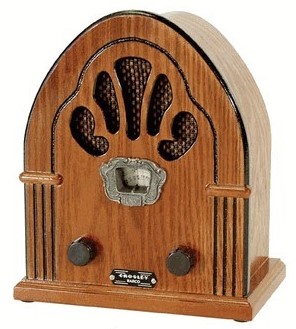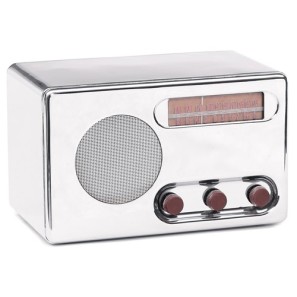BY DAN BANASIK
What makes something aesthetically pleasing? Whether architecture, products, graphics, animation, games, everything has aesthetic qualities. The challenge for the designer is that everyone perceives aesthetics differently. Sometimes it comes down to personal taste. What may appeal to some may not appeal to the masses. Distinguished industrial designer Raymond Loewy introduced the principle of Most Advanced Yet Acceptable (MAYA) to identify the sweet spot or aesthetic appeal between familiarity and uniqueness or what we refer to, respectively, as typicality and novelty today (Lidwell et al, 2010). Finding that balance can lead to great success, but is easier said than done.

Radio of the 1920’s. Retrieved from http://timerime.com/en/event/153239/The+Radio/

Raymond Loewy RCA Radio 1933. Retrieved from http://www.oobject.com/category/12-classic-raymond-loewy-designs/
According to Terry Stone, “each and every one of us goes through cultural training—intentional or unintentional—that forms our ideas of what is aesthetically pleasing” (Stone, 2012). A learned response that triggers emotions, feelings and all our senses – taste, smell, vision, hearing and touch. We all experience positive and negative relationships with products and environments on a daily basis. Sometimes we have choices and other times the choice is made for us. Take for example the reviled cable box. How frustrating is it to purchase a beautifully designed HDTV and then have to deal with an ugly cable box and accompanying remote? You don’t get a choice. Why doesn’t the TV manufacturer produce matching cable boxes or integrate them right into the TV itself? With such advanced technology available, it seems so simple.
Most of us find pleasure in making our own choices when it comes to personal purchases. Aesthetics play a large role in our decision process. But what about our design contributions? Are we aware of customer wants and desires or are we designing around personal preference? Nike introduced customization a few years back. This approach virtually eliminates the designer input and puts the customer in control. Is this where we are headed? Does this minimize the market value of design? I should hope not. When I designed woodworking tools, function and familiarity outweighed novelty in most cases. In that industry, the core demographic (males 55 and older) heavily influenced product acceptance. Ironically, the most successful product in the history of the company (to date) appeared to be more novel than functional until field-tested by the skeptics. The sweet spot had been found. Check out Rockler’s Bench Cookie Plus. Not only does this product hold your project steady while routing, sawing or sanding without the use of clamps, it meets or exceeds the definition of good value – aesthetically pleasing, high function, excellent build quality and the right price. This combination directly affects the bottom line.
We as designers have an obligation to create positive relationships between customer and product. So how would you classify your own designs? Are they familiar? Novel? Or have you discovered that MAYA sweet spot?
Bibliography
Lidwell, W., Holden, K., Butler, J., (2010). Universal principles of design, revised and updated. Rockport Publishers.
Stone, T.L. (2012, September 20). Evaluate aesthetic strategies. How. Retrieved from http://www.howdesign.com/parse/evaluating-aesthetic-strategies/
Forget the existence of yourself Zixu Tian
Design is to create something different from anything before, in other words, to change something from original. Every time I do the changing, I ask myself why I change it-if I get an idea now, why people didn’t come up with it in the past?
Of course not because I am more clever than everyone before. Sometimes it is because the improvement of new technology, and people can do something new-such as inter-net; sometimes it is because the new problems made by social development, and people need to deal with something new-just like environment pollution; these 2 subjective reasons are main motivation that push modern design forward. But even in the ancient time when the technology developed very slow, there were different styles in different periods of history. So there is another force contributing this to the change.
Human have never stopped pursuing truth, although different culture has different standard about what is right and what is wrong, deep inside there is something called humanity, which is the source of moral principles; and even sometimes we step backwards on that road, we still struggle to advance in the right direction. We are not always doing what is good for us, in fact we have a lot of bad habit-drink, drug and junk food, but then the sound of critic will point them out and we will fight it.
This is the force that make the changing, when we find that we are in a wrong direction or when we find a possible right direction, we will alter. It is everyone’s duty including designers to make people drive in the right path. So a designer should not offer what client want but what they need-what they really need.
To do that, we need to put ourselves in other one’s shoes-think what they think. But sometimes we can not do that because we have ourselves’ opinion which is depended on the environment around us and what we have experienced. So we need to forget ourselves and then we can put our soul into others body.
Our body and our image is just a mark, if we care too much about our physical body, we can not liberate our spirit. Who am I? What style I represent? Which group I belong to? All of these prevent us from finding the truth.
I will do the research and think for the user, and during this procedure, I will notice what is cause by my original opinion and get rid of it and at last, I will accept the result of the logic procedure.
LikeLike
Nice question to start with, what makes some thing aesthetically pleasing. I agree that cultural training influnses our likes and dislikes. For example in India black is a very bad color because the color represents an evil god. Because religion is important we generally avoid purchasing objects that are black in color. Even though I was brought up in that culture I personally like the color black and it when it comes to personal choice I would choose something black over other color options.
When it comes to my designs I design what I like. However if I work in the game industry I would most likely create designs by, and for, someone else to please a really large audience.
LikeLike
You bring up good points on the challenges of creating balanced designs on par with adapting to cultural change. Having been working in your discipline you’ve encountered real situations that question products and their MAYA target. I agree that aesthetic ideas are ingrained through our environment and/or heritage, as well as our generation. So it can become very subjective and breaking out of that ‘bias’ to attract others may be difficult (commercially speaking). So what NIKE did completely ruled out what aesthetics means to them and handed the controls over to the consumer as the ‘real’ designers, allowing consumers to use the NIKE brand to make a brand of their own. It reminds me of the ‘character customization’ in digital games that’s becoming increasingly popular. The designers let the user become the designer themselves, which adds for a more personal experience. This detail in design is empathetic to the user as it seems empathy plays a large role in design success. Most of the eight ways Jeneanne Rae mentioned in her article, “What is the Real Value of Design” has empathy as major player, such as Customer Service, the Wow Factor, Brand Expression, etc. I’m sure most designers know this, but the ultimate “don’t’s” in design is a product that tries to satisfy all demographics. So determining that sweet spot may be as controversial as what Beirut mentioned in his article about Tibor Kalman finding the ‘crazy’ entrepreneur and use their money to better the world. The idea of MAYA goes back to Czikszentmihalyi’s creative balance, that a creative individual must achieve gray from black and white. So, for a designer to achieve the sweet spot, I feel, the individual must first realize the MAYA in themselves before translating that idea into material for the masses, because our designs ultimately hinge on the balance in us, our morals and our sanity.
LikeLike
Sometimes as designers we hold too tight to the reigns, but sometimes its being able to loosen your grip on the reigns we find success. Adding customization to a product can elevate your product, people feel a bigger sense of ownership and attachment to things when they are allowed to take part in the process and final output. I think with allowing the consumer to have a place in the process we have the ability to get closer to MAYA. Our world changes so quickly that finding the sweet spot becomes increasingly more difficult. While I think its important to always keep the consumer in mind, I believe that one of the best ways we can cater to them is by listening and absorbing what it is that they are looking for. What kinds of needs they have and what they like or don’t like. It comes down to the details that will give design its impact.
LikeLike